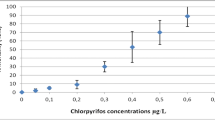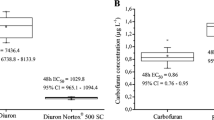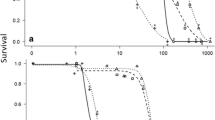Abstract
The sensitivities of seven cladoceran species (Ceriodaphnia reticulata, Chydorus sphaericus, Daphnia galeata, Diaphanosoma brachyurum, Moina macrocopa, Scapholeberis kingi, and Simocephalus vetulus) to carbamate insecticides (carbaryl and methomyl) were investigated by acute toxicity tests. The sensitivities to carbaryl and methomyl were highly correlated among the tested organisms, but the co-tolerance level varied markedly among species. C. reticulata showed the highest sensitivity, whereas M. macrocopa and S. kingi showed the lowest sensitivities to the two insecticides. These results indicate that the degree of chemical impacts on natural communities can vary depending on cladoceran species composition. The highly positive correlation between the EC50 values for both insecticides indicates that the two chemicals have a shared mode of action on cladoceran species. Unlike previous reports, acute toxicity was not correlated with body size. The results are discussed in relation to community-level experiments, the functions of freshwater ecosystems, and ecological risk assessment.


Similar content being viewed by others
References
Azam F, Fenchel T, Field J, Gray J, Meyer-Reid L, Thingstad F (1983) The ecological role of water-column microbes in the sea. Mar Ecol Prog Ser 10:257–263
Baird DJ, Barber I, Calow P (1990) Clonal variation in general responses of Daphnia magna Straus to toxic stress. I. chronic life-history effects. Funct Ecol 4:399–407
Barnett AJ, Finlay K, Beisner BE (2007) Functional diversity of crustacean zooplankton communities: toward a trait-based classification. Freshwat Biol 52:796–813
Bossuyt BTA, Janssen CR (2005) Copper toxicity to different field-collected cladoceran species: intra- and inter-species sensitivity. Environ Pollut 136:145–154
Brooks JL, Dodson SI (1965) Predation, body size, and composition of plankton. Science 150:28–35
Chang KH, Sakamoto M, Hanazato T (2005) Impact of pesticide application on zooplankton communities with different densities of invertebrate predators: an experimental analysis using small-scale mesocosms. Aquat Toxicol 72:373–382
Coors A, Joost V, De Bie T, De Meester L (2009) Land use, genetic diversity and toxicant tolerance in natural populations of Daphnia magna. Aquat Toxicol 95:71–79
Desmarais KH (1997) Keeping Daphnia out of the surface film with cetyl alcohol. J Plankton Res 19:149–154
Dumont HJ, Van de Velde I, Dumont S (1975) The dry weight estimation of biomass in a selection of Cladocera, Copepoda and Rotifera from to the plankton, periphyton and benthos of continental waters. Oecologia 19:75–97
Dzialowski AR, Smith VH (2008) Nutrient-dependent effects of consumer identity and diversity on freshwater ecosystem function. Freshwat Biol 53:148–158
Geller W, Müller H (1981) The filtration apparatus of Cladocera: filter mesh-sizes and their implications of food selectivity. Oecologia 49:316–321
Gliwicz ZM (1990) Food thresholds and body size in cladocerans. Nature 343:638–640
Hanazato T (1991) Effects of repeated application of carbaryl on zooplankton communities in experimental ponds with or without the predator Chaoborus. Environ Pollut 74:309–324
Hanazato T (1998) Response of a zooplankton community to insecticide application in experimental ponds: a review and the implications of the effects of chemicals on the structure and the functioning of freshwater communities. Environ Pollut 101:361–373
Hanazato T (2001) Pesticide effects on freshwater zooplankton: an ecological perspective. Environ Pollut 112:1–10
Hanazato T, Yasuno M (1990) Influence of Chaoborus density on the effects of an insecticide on zooplankton communities in ponds. Hydrobiologia 194:183–197
Hatakeyama S, Sugaya Y (1989) A freshwater shrimp (Paratya cimpressa improvisa) as a sensitive test organism to pesticides. Environ Pollut 59:325–336
Havens KE (1994) An experimental comparison of the effects of two chemical stressors on a freshwater zooplankton assemblage. Environ Pollut 84:245–251
Leibold MA (1989) Consumer–resource interactions in environmental gradients. Am Nat 134:922–949
Mayer FL, Ellersieck M (1986) Manual of acute toxicity: interpretation and data base for 410 chemicals and 66 species of freshwater animals. US Fish and Wildlife Service, Resource Publ no. 160, Washington, DC
McCauley E (1984) The estimation of the abundance and biomass of zooplankton in samples. In: Downing JA, Rigler FH (eds) A manual on methods for the assessment of secondary productivity in fresh waters, 2nd edn. Blackwell scientific, Oxford, pp 228–265
Newman MC, Clements WH (2008) Ecotoxicology: a comprehensive treatment. CRC Press, Boca Raton
Norberg J (1999) Resource-niche complementarity and autotrophic compensation determines ecosystem-level response to increased cladoceran species richness. Oecologia 122:264–272
Organisation for Economic Co-operation and Development (OECD) (2004) Daphnia sp., acute immobilization test, vol 202. OECD, Paris
Perrin N (1988) Why are offspring born larger when it is colder? Phenotypic plasticity for offspring size in the cladoceran Simocephalus vetulus (Müller). Funct Ecol 2:283–288
Posthuma L, Suter GW, Traas TP (2002) Species sensitivity distributions in ecotoxicology. Lewis Publishers, Boca Raton
Sakamoto M, Ogamino Y, Tanaka Y (2010) Leptodora kindtii: a cladoceran species highly sensitive to toxic chemicals. Limnology 11:193–196
Sarma SSS, Nandini S, Gulati RD (2005) Life history strategies of cladocerans: comparisons of tropical and temperate taxa. Hydrobiologia 542:315–333
Steiner CF, Darcy-Hall TL, Dorn NJ, Garcia EA, Mittelbach GG, Wojdak JM (2005) The influence of consumer diversity and indirect facilitation on trophic level biomass and stability. Oikos 110:556–566
Stockner JG, Porter KG (1988) Microbial food webs in freshwater planktonic ecosystems. In: Carpenter S (ed) Complex interactions in lake communities. Springer-Verlag, New York, pp 70–83
Suter GW II (2007) Ecological risk assessment. CRC Press, Boca Raton
Turner AM, Mittelbach GG (1992) Effect of grazer community composition and fish on algal dynamics. Can J Fish Aquat Sci 49:1908–1915
Van den Brink PJ, Crum SJH, Gylstra R, Bransen F, Cuppen JGM, Brock TCM (2009) Effects of a herbicide-insecticide mixture in freshwater microcosms: risk assessment and ecological effect chain. Environ Pollut 157:237–249
Vesela S, Vijverberg J (2007) Effect of body size on toxicity of zinc in neonates of four differently sized Daphnia species. Aquat Ecol 41:67–73
Wong LC, Kwok KWH, Leung KMY, Wong CK (2009) Relative sensitivity distribution of freshwater planktonic crustaceans to trace metals. Hum Ecol Risk Assess 15:1335–1345
Acknowledgments
We are grateful to Dr. Takehiko I. Hayashi of the National Institute for Environmental Studies for his helpful comments on the manuscript. The authors thank the staff of the National Institute for Environmental Studies, especially H. Ohyama and N. Sawabe, for their kind assistance in preparing tested organisms and their food resources.
Author information
Authors and Affiliations
Corresponding author
Rights and permissions
About this article
Cite this article
Mano, H., Sakamoto, M. & Tanaka, Y. A comparative study of insecticide toxicity among seven cladoceran species. Ecotoxicology 19, 1620–1625 (2010). https://doi.org/10.1007/s10646-010-0547-3
Accepted:
Published:
Issue Date:
DOI: https://doi.org/10.1007/s10646-010-0547-3




